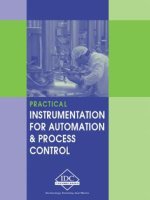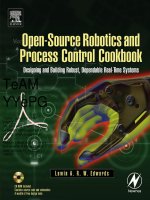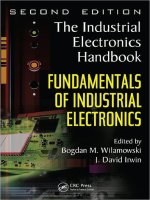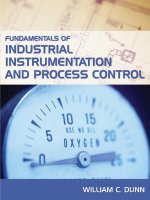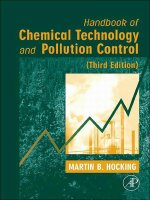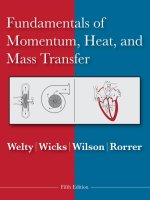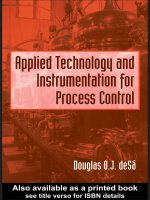fundamentals of industrial instrumentation and process control
Bạn đang xem bản rút gọn của tài liệu. Xem và tải ngay bản đầy đủ của tài liệu tại đây (4.03 MB, 337 trang )
Want to learn more?
We hope you enjoy this
McGraw-Hill eBook! If
you’d like more information about this book,
its author, or related books and websites,
please
click here.
Fundamentals of
Industrial Instrumentation
and Process Control
William C. Dunn
McGraw-Hill
New York Chicago San Francisco Lisbon London Madrid
Mexico City Milan New Delhi San Juan Seoul
Singapore Sydney Toronto
Copyright © 2005 by The McGraw-Hill Companies, Inc. All rights reserved. Manufactured in the
United States of America. Except as permitted under the United States Copyright Act of 1976, no part
of this publication may be reproduced or distributed in any form or by any means, or stored in a
database or retrieval system, without the prior written permission of the publisher.
0-07-146693-2
The material in this eBook also appears in the print version of this title: 0-07-145735-6.
All trademarks are trademarks of their respective owners. Rather than put a trademark symbol after
every occurrence of a trademarked name, we use names in an editorial fashion only, and to the benefit
of the trademark owner, with no intention of infringement of the trademark. Where such designations
appear in this book, they have been printed with initial caps. McGraw-Hill eBooks are available at
special quantity discounts to use as premiums and sales promotions, or for use in corporate training
programs. For more information, please contact George Hoare, Special Sales, at
or (212) 904-4069.
TERMS OF USE
This is a copyrighted work and The McGraw-Hill Companies, Inc. (“McGraw-Hill”) and its licensors
reserve all rights in and to the work. Use of this work is subject to these terms. Except as permitted
under the Copyright Act of 1976 and the right to store and retrieve one copy of the work, you may not
decompile, disassemble, reverse engineer, reproduce, modify, create derivative works based upon,
transmit, distribute, disseminate, sell, publish or sublicense the work or any part of it without
McGraw-Hill’s prior consent. You may use the work for your own noncommercial and personal use;
any other use of the work is strictly prohibited. Your right to use the work may be terminated if you
fail to comply with these terms.
THE WORK IS PROVIDED “AS IS.” McGRAW-HILL AND ITS LICENSORS MAKE NO
GUARANTEES OR WARRANTIES AS TO THE ACCURACY, ADEQUACY OR
COMPLETENESS OF OR RESULTS TO BE OBTAINED FROM USING THE WORK,
INCLUDING ANY INFORMATION THAT CAN BE ACCESSED THROUGH THE WORK VIA
HYPERLINK OR OTHERWISE, AND EXPRESSLY DISCLAIM ANY WARRANTY, EXPRESS
OR IMPLIED, INCLUDING BUT NOT LIMITED TO IMPLIED WARRANTIES OF
MERCHANTABILITY OR FITNESS FOR A PARTICULAR PURPOSE. McGraw-Hill and its
licensors do not warrant or guarantee that the functions contained in the work will meet your
requirements or that its operation will be uninterrupted or error free. Neither McGraw-Hill nor its
licensors shall be liable to you or anyone else for any inaccuracy, error or omission, regardless of
cause, in the work or for any damages resulting therefrom. McGraw-Hill has no responsibility for the
content of any information accessed through the work. Under no circumstances shall McGraw-Hill
and/or its licensors be liable for any indirect, incidental, special, punitive, consequential or similar
damages that result from the use of or inability to use the work, even if any of them has been advised
of the possibility of such damages. This limitation of liability shall apply to any claim or cause
whatsoever whether such claim or cause arises in contract, tort or otherwise.
DOI: 10.1036/0071466932
To my wife Nadine for her patience, understanding,
and many helpful suggestions during the writing of
this text
v
Contents
Preface xiii
Chapter 1. Introduction and Review 1
Chapter Objectives 1
1.1 Introduction 1
1.2 Process Control 2
1.3 Definitions of the Elements in a Control Loop 3
1.4 Process Facility Considerations 6
1.5 Units and Standards 7
1.6 Instrument Parameters 9
Summary 13
Problems 13
Chapter 2. Basic Electrical Components 15
Chapter Objectives 15
2.1 Introduction 15
2.2 Resistance 16
2.2.1 Resistor formulas 17
2.2.2 Resistor combinations 19
2.2.3 Resistive sensors 23
2.3 Capacitance 24
2.3.1 Capacitor formulas 24
2.3.2 Capacitor combinations 25
2.4 Inductance 26
2.4.1 Inductor formulas 26
2.4.2 Inductor combinations 27
Summary 27
Problems 28
Chapter 3. AC Electricity 31
Chapter Objectives 31
3.1 Introduction 31
3.2 Circuits with R, L, and C 32
For more information about this title, click here
3.2.1 Voltage step 32
3.2.2 Time constants 33
3.2.3 Phase change 35
3.3 RC Filters 38
3.4 AC Bridges 39
3.5 Magnetic Forces 40
3.5.1 Magnetic fields 40
3.5.2 Analog meter 42
3.5.3 Electromechanical devices 43
Summary 44
Problems 45
Chapter 4. Electronics 47
Chapter Objectives 47
4.1 Introduction 48
4.2 Analog Circuits 48
4.2.1 Discrete amplifiers 48
4.2.2 Operational amplifiers 49
4.2.3 Current amplifiers 53
4.2.4 Differential amplifiers 54
4.2.5 Buffer amplifiers 55
4.2.6 Nonlinear amplifiers 56
4.2.7 Instrument amplifier 56
4.2.8 Amplifier applications 57
4.3 Digital Circuits 58
4.3.1 Digital signals 58
4.3.2 Binary numbers 58
4.3.3 Logic circuits 60
4.3.4 Analog-to-digital conversion 61
4.4 Circuit Considerations 63
Summary 63
Problems 64
Chapter 5. Pressure 67
Chapter Objectives 67
5.1 Introduction 67
5.2 Basic Terms 68
5.3 Pressure Measurement 69
5.4 Pressure Formulas 70
5.5 Measuring Instruments 73
5.5.1 Manometers 73
5.5.2 Diaphragms, capsules, and bellows 75
5.5.3 Bourdon tubes 77
5.5.4 Other pressure sensors 79
5.5.5 Vacuum instruments 79
5.6 Application Considerations 80
5.6.1 Selection 80
5.6.2 Installation 80
5.6.3 Calibration 81
Summary 81
Problems 82
vi Contents
Chapter 6. Level 85
Chapter Objectives 85
6.1 Introduction 85
6.2 Level Formulas 86
6.3 Level Sensing Devices 87
6.3.1 Direct level sensing 88
6.3.2 Indirect level sensing 92
6.4 Application Considerations 95
Summary 97
Problems 97
Chapter 7. Flow 99
Chapter Objectives 99
7.1 Introduction 99
7.2 Basic Terms 100
7.3 Flow Formulas 102
7.3.1 Continuity equation 102
7.3.2 Bernoulli equation 103
7.3.3 Flow losses 105
7.4 Flow Measurement Instruments 107
7.4.1 Flow rate 107
7.4.2 Total flow 111
7.4.3 Mass flow 112
7.4.4 Dry particulate flow rate 113
7.4.5 Open channel flow 113
7.5 Application Considerations 114
7.5.1 Selection 114
7.5.2 Installation 115
7.5.3 Calibration 115
Summary 115
Problems 116
Chapter 8. Temperature and Heat 119
Chapter Objectives 119
8.1 Introduction 119
8.2 Basic Terms 120
8.2.1 Temperature definitions 120
8.2.2 Heat definitions 121
8.2.3 Thermal expansion definitions 123
8.3 Temperature and Heat Formulas 124
8.3.1 Temperature 124
8.3.2 Heat transfer 124
8.3.3 Thermal expansion 126
8.4 Temperature Measuring Devices 127
8.4.1 Thermometers 127
8.4.2 Pressure-spring thermometers 129
8.4.3 Resistance temperature devices 130
8.4.4 Thermistors 131
8.4.5 Thermocouples 131
8.4.6 Semiconductors 133
Contents vii
8.5 Application Considerations 134
8.5.1 Selection 134
8.5.2 Range and accuracy 134
8.5.3 Thermal time constant 134
8.5.4 Installation 137
8.5.5 Calibration 137
8.5.6 Protection 137
Summary 138
Problems 138
Chapter 9. Humidity, Density,Viscosity, and pH 141
Chapter Objectives 141
9.1 Introduction 141
9.2 Humidity 142
9.2.1 Humidity definitions 142
9.2.2 Humidity measuring devices 146
9.3 Density and Specific Gravity 149
9.3.1 Basic terms 149
9.3.2 Density measuring devices 150
9.3.3 Density application considerations 153
9.4 Viscosity 153
9.4.1 Basic terms 153
9.4.2 Viscosity measuring instruments 154
9.5 pH Measurements 155
9.5.1 Basic terms 155
9.5.2 pH measuring devices 156
9.5.3 pH application considerations 156
Summary 157
Problems 158
Chapter 10. Other Sensors 161
Chapter Objectives 161
10.1 Introduction 161
10.2 Position and Motion Sensing 161
10.2.1 Basic position definitions 161
10.2.2 Position and motion measuring devices 163
10.2.3 Position application consideration 166
10.3 Force, Torque, and Load Cells 166
10.3.1 Basic definitions of force and torque 166
10.3.2 Force and torque measuring devices 167
10.3.3 Force and torque application considerations 170
10.4 Smoke and Chemical Sensors 170
10.4.1 Smoke and chemical measuring devices 171
10.4.2 Smoke and chemical application consideration 171
10.5 Sound and Light 171
10.5.1 Sound and light formulas 171
10.5.2 Sound and light measuring devices 173
10.5.3 Light sources 174
10.5.4 Sound and light application considerations 174
Summary 176
Problems 176
viii Contents
Chapter 11. Actuators and Control 179
Chapter Objectives 179
11.1 Introduction 179
11.2 Pressure Controllers 180
11.2.1 Regulators 180
11.2.2 Safety valves 182
11.2.3 Level regulators 182
11.3 Flow Control Actuators 183
11.3.1 Globe valve 183
11.3.2 Butterfly valve 185
11.3.3 Other valve types 185
11.3.4 Valve characteristics 186
11.3.5 Valve fail safe 187
11.4 Power Control 188
11.4.1 Electronic devices 188
11.4.2 Magnetic control devices 193
11.5 Motors 195
11.5.1 Servo motors 195
11.5.2 Stepper motors 195
11.5.3 Valve position feedback 196
11.5.4 Pneumatic feedback 196
11.6 Application Considerations 196
11.6.1 Valves 196
11.6.2 Power devices 197
Summary 198
Problems 198
Chapter 12. Signal Conditioning 201
Chapter Objectives 201
12.1 Introduction 201
12.2 Conditioning 202
12.2.1 Characteristics 202
12.2.2 Linearization 204
12.2.3 Temperature correction 205
12.3 Pneumatic Signal Conditioning 205
12.4 Visual Display Conditioning 206
12.4.1 Direct reading sensors 206
12.5 Electrical Signal Conditioning 207
12.5.1 Linear sensors 208
12.5.2 Float sensors 208
12.5.3 Strain gauge sensors 211
12.5.4 Capacitive sensors 212
12.5.5 Resistance sensors 213
12.5.6 Magnetic sensors 214
12.5.7 Thermocouple sensors 215
12.5.8 Other sensors 215
12.6 A-D Conversion 216
Summary 216
Problems 216
Contents ix
Chapter 13. Signal Transmission 219
Chapter Objectives 219
13.1 Introduction 220
13.2 Pneumatic Transmission 220
13.3 Analog Transmission 220
13.3.1 Noise considerations 220
13.3.2 Voltage signals 222
13.3.3 Current signals 223
13.3.4 Signal conversion 223
13.3.5 Thermocouples 224
13.3.6 Resistance temperature devices 225
13.4 Digital Transmission 226
13.4.1 Transmission standards 226
13.4.2 Smart sensors 227
13.4.3 Foundation Fieldbus and Profibus 229
13.5 Controller 230
13.5.1 Controller operation 231
13.5.2 Ladder diagrams 232
13.6 Digital-to-Analog Conversion 235
13.6.1 Digital-to-analog converters 235
13.6.2 Pulse width modulation 236
13.7 Telemetry 237
13.7.1 Width modulation 237
13.7.2 Frequency modulation 238
Summary 239
Problems 239
Chapter 14. Process Control 241
Chapter Objectives 241
14.1 Introduction 241
14.2 Basic Terms 242
14.3 Control Modes 243
14.3.1 ON/OFF action 243
14.3.2 Differential action 244
14.3.3 Proportional action 244
14.3.4 Derivative action 246
14.3.5 Integral action 247
14.3.6 PID action 248
14.4 Implementation of Control Loops 249
14.4.1 ON/OFF action pneumatic controller 249
14.4.2 ON/OFF action electrical controller 250
14.4.3 PID action pneumatic controller 251
14.4.4 PID action control circuits 252
14.4.5 PID electronic controller 254
14.5 Digital Controllers 256
Summary 257
Problems 257
Chapter 15. Documentation and Symbols 259
Chapter Objectives 259
15.1 Introduction 259
x Contents
15.2 System Documentation 260
15.2.1 Alarm and trip systems 260
15.2.2 Alarm and trip documentation 261
15.2.3 PLC documentation 261
15.3 Pipe and Identification Diagrams 262
15.3.1 Standardization 262
15.3.2 Interconnections 262
15.3.3 Instrument symbols 263
15.3.4 Instrument identification 264
15.4 Functional Symbols 266
15.4.1 Actuators 266
15.4.2 Primary elements 266
15.4.3 Regulators 267
15.4.4 Math functions 267
15.5 P and ID Drawings 267
Summary 269
Problems 271
Appendix A. Units 273
Appendix B. Thermocouple Tables 277
Appendix C. References and Information Resources 279
Appendix D. Abbreviations 283
Glossary 287
Answers to Odd-Numbered Questions 297
Index 311
Contents xi
ABOUT THE AUTHOR
William Dunn has B.Sc. in physics from the University of
London, graduating with honors, he also has a B.S.E.E. He
has over 40 years industrial experience in management,
marketing support, customer interfacing, and advanced
product development in systems and microelectronic and
micromachined sensor development. Most recently he taught
industrial instrumentation, and digital logic at Ouachita
Technical College as an adjunct professor. Previously he was
with Motorola Semiconductor Product Sector working in
advanced product development, designing micromachined
sensors and transducers. He holds some 15 patents in sensor
design, and has presented some 20 technical papers in sensor
design and application.
Copyright © 2005 by The McGraw-Hill Companies, Inc. Click here for terms of use.
Preface
Instrumentation and process control can be traced back many millennia. Some
of the early examples are the process of making fire and instruments using the
sun and stars, such as Stonehenge. The evolution of instrumentation and process
control has undergone several industrial revolutions leading to the complexi-
ties of modern day microprocessor-controlled processing. Today’s technological
evolution has made it possible to measure parameters deemed impossible only
a few years ago. Improvements in accuracy, tighter control, and waste reduc-
tion have also been achieved.
This book was specifically written as an introduction to modern day indus-
trial instrumentation and process control for the two-year technical, voca-
tional, or degree student, and as a reference manual for managers, engineers,
and technicians working in the field of instrumentation and process control.
It is anticipated that the prospective student will have a basic understanding
of mathematics, electricity, and physics. This course should adequately pre-
pare a prospective technician, or serve as an introduction for a prospective
engineer wishing to get a solid basic understanding of instrumentation and
process control.
Instrumentation and process control involve a wide range of technologies and
sciences, and they are used in an unprecedented number of applications.
Examples range from the control of heating, cooling, and hot water systems in
homes and offices to chemical and automotive instrumentation and process
control. This book is designed to cover all aspects of industrial instrumentation,
such as sensing a wide range of variables, the transmission and recording of the
sensed signal, controllers for signal evaluation, and the control of the manu-
facturing process for a quality and uniform product.
Chapter 1 gives an introduction to industrial instrumentation. Chapters 2
through 4 refresh the student’s knowledge of basic electricity and introduce
electrical circuits for use in instrumentation. Sensors and their use in the meas-
urement of a wide variety of physical variables—such as level, pressure, flow,
temperature, humidity, and mechanical measurements—are discussed in
Chapters 5 through 10. The use of regulators and actuators for controlling pres-
sure, flow, and the control of the input variables to a process are discussed in
xiii
Copyright © 2005 by The McGraw-Hill Companies, Inc. Click here for terms of use.
Chapter 11. Electronics is the medium for sensor signal amplification, condi-
tioning, transmission, and control. These functions are presented as they apply
to process control in Chapters 12 through 14. Finally, in Chapter 15, documen-
tation as applied to instrumentation and control is introduced, together with
standard symbols recommended by the Instrument Society of America (ISA) for
use in instrumentation control diagrams.
The primary reason for writing this book was that the author felt that there
was no clear, concise, and up-to-date book for prospective technicians and engi-
neers which could help them understand the basics of instrumentation and
process control. Every effort has been made to ensure that the book is accurate,
easily readable, and understandable.
Both engineering and scientific units are discussed in the book. Each chap-
ter contains worked examples for clarification, with exercise problems at the end
of each chapter. A glossary and answers to the odd-numbered questions are
given at the end of the book.
William C. Dunn
xiv Preface
Chapter
1
Introduction and Review
Chapter Objectives
This chapter will introduce you to instrumentation, the various measurement
units used, and the reason why process control relies extensively on instru-
mentation. It will help you become familiar with instrument terminology and
standards.
This chapter discusses
■
The basics of a process control loop
■
The elements in a control loop
■
The difference between the various types of variables
■
Considerations in a process facility
■
Units, standards, and prefixes used in parameter measurements
■
Comparison of the English and the SI units of measurement
■
Instrument accuracy and parameters that affect an instrument’s performance
1.1 Introduction
Instrumentation is the basis for process control in industry. However, it comes
in many forms from domestic water heaters and HVAC, where the variable
temperature is measured and used to control gas, oil, or electricity flow to the
water heater, or heating system, or electricity to the compressor for refrigera-
tion, to complex industrial process control applications such as used in the
petroleum or chemical industry.
In industrial control a wide number of variables, from temperature, flow, and
pressure to time and distance, can be sensed simultaneously. All of these can
be interdependent variables in a single process requiring complex microprocessor
systems for total control. Due to the rapid advances in technology, instruments
1
Copyright © 2005 by The McGraw-Hill Companies, Inc. Click here for terms of use.
in use today may be obsolete tomorrow, as new and more efficient measurement
techniques are constantly being introduced. These changes are being driven by
the need for higher accuracy, quality, precision, and performance. To measure
parameters accurately, techniques have been developed that were thought
impossible only a few years ago.
1.2 Process Control
In order to produce a product with consistently high quality, tight process con-
trol is necessary. A simple-to-understand example of process control would be
the supply of water to a number of cleaning stations, where the water temper-
ature needs to be kept constant in spite of the demand. A simple control block
is shown in Fig. 1.1a, steam and cold water are fed into a heat exchanger, where
heat from the steam is used to bring the cold water to the required working tem-
perature. A thermometer is used to measure the temperature of the water (the
measured variable) from the process or exchanger. The temperature is observed
by an operator who adjusts the flow of steam (the manipulated variable) into
the heat exchanger to keep the water flowing from the heat exchanger at the
constant set temperature. This operation is referred to as process control, and
in practice would be automated as shown in Fig. 1.1b.
Process control is the automatic control of an output variable by sensing the
amplitude of the output parameter from the process and comparing it to the
desired or set level and feeding an error signal back to control an input variable—
in this case steam. See Fig. 1.1b. A temperature sensor attached to the outlet
pipe senses the temperature of the water flowing. As the demand for hot water
increases or decreases, a change in the water temperature is sensed and con-
verted to an electrical signal, amplified, and sent to a controller that evaluates
the signal and sends a correction signal to an actuator. The actuator adjusts the
flow of steam to the heat exchanger to keep the temperature of the water at its
predetermined value.
2 Chapter One
Figure 1.1 Process control (a) shows the manual control of a simple heat exchanger process
loop and (b) automatic control of a heat exchanger process loop.
The diagram in Fig. 1.1b is an oversimplified feedback loop and is expanded
in Fig. 1.2. In any process there are a number of inputs, i.e., from chemicals to
solid goods. These are manipulated in the process and a new chemical or com-
ponent emerges at the output. The controlled inputs to the process and the
measured output parameters from the process are called variables.
In a process-control facility the controller is not necessarily limited to one vari-
able, but can measure and control many variables. A good example of the meas-
urement and control of multivariables that we encounter on a daily basis is given
by the processor in the automobile engine. Figure 1.3 lists some of the functions
performed by the engine processor. Most of the controlled variables are six or eight
devices depending on the number of cylinders in the engine. The engine processor
has to perform all these functions in approximately 5 ms. This example of engine
control can be related to the operations carried out in a process-control operation.
1.3 Definitions of the Elements in a Control Loop
Figure 1.4 breaks down the individual elements of the blocks in a process-control
loop. The measuring element consists of a sensor, a transducer, and a transmitter
with its own regulated power supply. The control element has an actuator, a power
control circuit, and its own power supply. The controller has a processor with a
Introduction and Review 3
Figure 1.2 Block diagram of a process control loop.
Figure 1.3 Automotive engine showing some of the measured and controlled variables.
memory and a summing circuit to compare the set point to the sensed signal so
that it can generate an error signal. The processor then uses the error signal to
generate a correction signal to control the actuator and the input variable. The func-
tion and operation of the blocks in different types of applications will be discussed
in Chaps. 11, 12, and 14. The definition of these blocks is given as follows:
Feedback loop is the signal path from the output back to the input to correct
for any variation between the output level from the set level. In other words,
the output of a process is being continually monitored, the error between the
set point and the output parameter is determined, and a correction signal is
then sent back to one of the process inputs to correct for changes in the meas-
ured output parameter.
Controlled or measured variable is the monitored output variable from a
process. The value of the monitored output parameter is normally held within
tight given limits.
Manipulated variable is the input variable or parameter to a process that is
varied by a control signal from the processor to an actuator. By changing the
input variable the value of the measured variable can be controlled.
Set point is the desired value of the output parameter or variable being mon-
itored by a sensor. Any deviation from this value will generate an error signal.
Instrument is the name of any of the various device types for indicating or
measuring physical quantities or conditions, performance, position, direc-
tion, and the like.
Sensors are devices that can detect physical variables, such as temperature,
light intensity, or motion, and have the ability to give a measurable output
that varies in relation to the amplitude of the physical variable. The human
body has sensors in the fingers that can detect surface roughness, temperature,
and force. A thermometer is a good example of a line-of-sight sensor, in that
4 Chapter One
Figure 1.4 Block diagram of the elements that make up the feedback path in a
process-control loop.
it will give an accurate visual indication of temperature. In other sensors
such as a diaphragm pressure sensor, a strain transducer may be required to
convert the deformation of the diaphragm into an electrical or pneumatic
signal before it can be measured.
Transducers are devices that can change one form of energy to another, e.g.,
a resistance thermometer converts temperature into electrical resistance, or
a thermocouple converts temperature into voltage. Both of these devices give
an output that is proportional to the temperature. Many transducers are
grouped under the heading of sensors.
Converters are devices that are used to change the format of a signal without
changing the energy form, i.e., a change from a voltage to a current signal.
Actuators are devices that are used to control an input variable in response
to a signal from a controller. Atypical actuator will be a flow-control valve that
can control the rate of flow of a fluid in proportion to the amplitude of an elec-
trical signal from the controller. Other types of actuators are magnetic relays
that turn electrical power on and off. Examples are actuators that control
power to the fans and compressor in an air-conditioning system in response
to signals from the room temperature sensors.
Controllers are devices that monitor signals from transducers and take the
necessary action to keep the process within specified limits according to a pre-
defined program by activating and controlling the necessary actuators.
Programmable logic controllers (PLC) are used in process-control applica-
tions, and are microprocessor-based systems. Small systems have the ability
to monitor several variables and control several actuators, with the capabil-
ity of being expanded to monitor 60 or 70 variables and control a correspon-
ding number of actuators, as may be required in a petrochemical refinery.
PLCs, which have the ability to use analog or digital input information and
output analog or digital control signals, can communicate globally with other
controllers, are easily programmed on line or off line, and supply an unprece-
dented amount of data and information to the operator. Ladder networks are
normally used to program the controllers.
An error signal is the difference between the set point and the amplitude of
the measured variable.
A correction signal is the signal used to control power to the actuator to set
the level of the input variable.
Transmitters are devices used to amplify and format signals so that they are suit-
able for transmission over long distances with zero or minimal loss of informa-
tion. The transmitted signal can be in one of the several formats, i.e., pneumatic,
digital, analog voltage, analog current, or as a radio frequency (RF) modulated
signal. Digital transmission is preferred in newer systems because the con-
troller is a digital system, and as analog signals can be accurately digitized, dig-
ital signals can be transmitted without loss of information. The controller
compares the amplitude of the signal from the sensor to a predetermined set
Introduction and Review 5
point, which in Fig. 1.1b is the amplitude of the signal of the hot water sensor.
The controller will then send a signal that is proportional to the difference
between the reference and the transmitted signal to the actuator telling the
actuator to open or close the valve controlling the flow of steam to adjust the
temperature of the water to its set value.
Example 1.1 Figure 1.5 shows the block diagram of a closed-loop flow control system.
Identify the following elements: (a) the sensor, (b) the transducer, (c) the actuator, (d) the
transmitter, (e) the controller, (f) the manipulated variable, and (g) the measured variable.
(a) The sensor is labeled pressure cell in the diagram. (b) The transducer is labeled
converter. There are two transducers—one for converting pressure to current and the
other for converting current to pressure to operate the actuator. (c) The actuator in
this case is the pneumatic valve. (d) The transmitter is the line driver. (e) The controller
is labeled PLC. (f) The manipulated variable is the differential pressure developed by
the fluid flowing through the orifice plate constriction. (g) The controlled variable is
the flow rate of the liquid.
Simple and ideal process-control systems have been discussed. In practical process
control the scenarios are much more complex with many scenarios and variables,
such as stability, reaction time, and accuracy to be considered. Many of the basic
problems are discussed in the following chapters.
1.4 Process Facility Considerations
The process facility has a number of basic requirements including safety pre-
cautions and well-regulated, reliable electrical, water, and air supplies.
An electrical supply is required for all control systems and must meet all stan-
dards in force at the plant. The integrity of the electrical supply is most important.
Many facilities have backup systems to provide an uninterruptible power supply
(UPS) to take over in case of loss of external power. Power failure can mean plant
shutdown and the loss of complete production runs. An isolating transformer
should be used in the power supply lines to prevent electromagnetic interference
6 Chapter One
Figure 1.5 Process control with a flow regulator for use in Example 1.1.
(EMI) generated by motors, contactors, relays, and so on from traveling through
the power lines and affecting sensitive electronic control instruments.
Grounding is a very important consideration in a facility for safety reasons.
Any variations in the ground potential between electronic equipment can cause
large errors in signal levels. Each piece of equipment should be connected to a
heavy copper bus that is properly grounded. Ground loops should also be avoided
by grounding cable screens and signal return lines at one end only. In some cases
it may be necessary to use signal isolators to alleviate grounding problems in
electronic devices and equipment.
An air supply is required to drive pneumatic actuators in most facilities.
Instrument air in pneumatic equipment must meet quality standards, the air
must be dirt, oil, contaminant, and moisture free. Frozen moisture, dirt, and the
like can fully or partially block narrowed sections and nozzles, giving false read-
ings or complete equipment failure. Air compressors are fitted with air dryers
and filters, and have a reservoir tank with a capacity large enough for several
minutes’ supply in case of system failure. Dry, clean air is supplied at a pres-
sure of 90 psig (630 kPa⋅g) and with a dew point of 20°F (10°C) below the min-
imum winter operating temperature at atmospheric pressure. Additional
information on the quality of instrument air can be found in ANSI/ISA-7.0.01-
1996, Quality Standard for Instrument Air.
Water supply is required in many cleaning and cooling operations, and for
steam generation. Domestic water supplies contain large quantities of particu-
lates and impurities, and may be satisfactory for cooling, but are not suitable
for most cleaning operations. Filtering and other similar processes can remove
some of the contaminants making the water suitable for some cleaning opera-
tions, but for ultrapure water a reverse osmosis system may be required.
Installation and maintenance must be considered when locating instruments,
valves and so on. Each device must be easily accessible for maintenance and
inspection. It may also be necessary to install hand-operated valves so that
equipment can be replaced or serviced without complete plant shutdown. It may
be necessary to contract out maintenance of certain equipment or have the
vendor install equipment, if the necessary skills are not available in-house.
Safety is a top priority in a facility. The correct material must be used in con-
tainer construction, plumbing, seals, and gaskets to prevent corrosion and fail-
ure leading to leakage and spills of hazardous materials. All electrical equipment
must be properly installed to code with breakers. Electrical systems must have
the correct fire retardant for use in case of electrical fires. More information can
be found in ANSI/ISA-12.01.01-1999, Definitions and Information Pertaining to
Electrical Instruments in Hazardous Locations.
1.5 Units and Standards
As with all disciplines, a set of standards has evolved over the years to ensure
consistency and avoid confusion. The Instrument Society of America (ISA) has
developed a complete list of symbols for instruments, instrument identifica-
tion, and process control drawings, which will be discussed in Chap. 15.
Introduction and Review 7
The units of measurement fall into two distinct systems; first, the English
system and second, the International system, SI (Systéme International D’Unités)
based on the metric system, but there are some differences. The English system
has been the standard used in the United States, but the SI system is slowly
making inroads, so that students need to be aware of both systems of units and
be able to convert units from one system to the other. Confusion can arise over some
units such as pound mass and pound weight. The unit for pound mass is the slug
(no longer in common use), which is the equivalent of the kilogram in the SI system
of units whereas pound weight is a force similar to the newton, which is the unit
of force in the SI system. The conversion factor of 1 lb = 0.454 kg, which is used to
convert mass (weight) between the two systems, is in effect equating 1-lb force to
0.454-kg mass; this being the mass that will produce a force of 4.448 N or a force
of 1 lb. Care must be taken not to mix units of the two systems. For consistency
some units may have to be converted before they can be used in an equation.
Table 1.1 gives a list of the base units used in instrumentation and meas-
urement in the English and SI systems and also the conversion factors, other
units are derived from these base units.
Example 1.2 How many meters are there in 110 yard?
110 yard = 330 ft = (330 × 0.305) m = 100.65 m
Example 1.3 What is the equivalent length in inches of 2.5 m?
2.5 m = (2.5/0.305) ft = 8.2 ft = 98.4 in
Example 1.4 The weight of an object is 2.5 lb. What is the equivalent force and mass
in the SI system of units?
2.5 lb = (2.5 × 4.448) N = 11.12 N
2.5 lb = (2.5 × 0.454) kg = 1.135 kg
Table 1.2 gives a list of some commonly used units in the English and SI sys-
tems, conversion between units, and also their relation to the base units. As
explained above the lb is used as both the unit of mass and the unit of force.
8 Chapter One
TABLE 1.1 Basic Units
Quantity English SI
Base units Units Symbol Units Symbol Conversion to SI
Length Foot ft Meter m 1 ft = 0.305 m
Mass Pound (slug) lb (slug) Kilogram kg 1 lb(slug) = 14.59 kg
Time Second s Second s
Temperature Rankine R Kelvin K 1°R = 5/9 K
Electric current Ampere A Ampere A
Hence, the unit for the lb in energy and power is mass, whereas the unit for the
lb in pressure is force, where the lb (force) = lb (mass) × g (force due to gravity).
Example 1.5 What is the pressure equivalent of 18 psi in SI units?
1 psi = 6.897 kPa
18 psi = (18 × 6.897) kPa = 124 kPa
Standard prefixes are commonly used for multiple and submultiple quanti-
ties to cover the wide range of values used in measurement units. These are
given in Table 1.3
1.6 Instrument Parameters
The accuracy of an instrument or device is the difference between the indicated
value and the actual value. Accuracy is determined by comparing an indi-
cated reading to that of a known standard. Standards can be calibrated devices
or obtained from the National Institute of Standards and Technology (NIST).
Introduction and Review 9
TABLE 1.2 Units in Common Use in the English and SI System
English SI
Quantity Name Symbol Units Name Symbol Units
Frequency Hertz Hertz Hz s
−1
Energy Foot-pound ft⋅lb lb⋅ft
2
/s
2
Joule J kg⋅m
2
/s
2
Force Pound lb lb⋅ft/s
2
Newton N kg⋅m/s
2
Resistance Ohm Ohm Ω kg⋅m
2
per (s
3
⋅A
2
)
Electric Potential Volt Volt V A⋅Ω
Pressure Pound psi lb/in
2
Pascal Pa N/m
2
per in
2
Charge Coulomb Coulomb C A⋅s
Inductance Henry Henry H kg⋅m
2
per (s
2
⋅A
2
)
Capacitance Farad Farad F s
4
⋅A
2
per (kg⋅m
2
)
Magnetic flux Weber Wb V⋅s
Power Horsepower hp lb⋅ft
2
/s
3
Watt W J/s
Conversion to SI
1 ft⋅lb = 1.356 J
1 lb (F) = 4.448 N
1 psi = 6897 Pa
1 hp = 746 W
This is the government organization that is responsible for setting and main-
taining standards, and developing new standards as new technology requires
it. Accuracy depends on linearity, hysteresis, offset, drift, and sensitivity. The
resulting discrepancy is stated as a ± deviation from the true value, and is nor-
mally specified as a percentage of full-scale reading or deflection (%FSD).
Accuracy can also be expressed as the percentage of span, percentage of read-
ing, or an absolute value.
Example 1.6 A pressure gauge ranges from 0 to 50 psi, the worst-case spread in
readings is ±4.35 psi. What is the %FSD accuracy?
%FSD =±(4.35 psi/50 psi) × 100 =±8.7
The range of an instrument specifies the lowest and highest readings it can
measure, i.e., a thermometer whose scale goes from −40°C to 100°C has a range
from −40°C to 100°C.
The span of an instrument is its range from the minimum to maximum scale
value, i.e., a thermometer whose scale goes from −40°C to 100°C has a span of
140°C. When the accuracy is expressed as the percentage of span, it is the devi-
ation from true expressed as a percentage of the span.
Reading accuracy is the deviation from true at the point the reading is being
taken and is expressed as a percentage, i.e., if a deviation of ±4.35 psi in Example
1.6 was measured at 28.5 psi, the reading accuracy would be (4.35/28.5) × 100 =
±15.26% of reading.
Example 1.7 In the data sheet of a scale capable of weighing up to 200 lb, the accuracy
is given as ±2.5 percent of a reading. What is the deviation at the 50 and 100 lb
readings, and what is the %FSD accuracy?
Deviation at 50 lb =±(50 × 2.5/100) lb =±1.25 lb
Deviation at 100 lb =±(100 × 2.5/100) lb =±2.5 lb
Maximum deviation occurs at FSD, that is, ±5 lb or ±2.5% FSD
The absolute accuracy of an instrument is the deviation from true as a number
not as a percentage, i.e., if a voltmeter has an absolute accuracy of ±3 V in the
10 Chapter One
TABLE 1.3 Standard Prefixes
Multiple Prefix Symbol Multiple Prefix Symbol
10
12
tera T 10
−2
centi c
10
9
giga G 10
−3
milli m
10
6
mega M 10
−6
micro µ
10
3
kilo k 10
−9
nano n
10
2
hecto h 10
−12
pico p
10 deka da 10
−15
femto f
10
−1
deci d 10
−18
atto a
